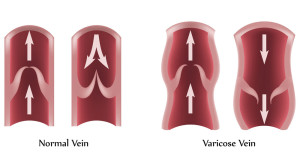Varicose vein surgery is done for varicose veins that are tortuous, mostly on the lower legs.
They are responsible for tired legs, heaviness in the leg, burning legs and all of this tends to get worse over the years. Initially they are harmless. But as the years go by there is a danger that the so-called communicating or perforating veins (perforators) to the deep veins of the legs can also get diseased with a loss of the vein valves.
They work like heart valves and transport the blood in only one direction, namely in the case of leg veins against gravity back into the direction of the right heart chamber. Back in the 1960’s in Europe varicose treatment was first done with a sclerosing agent that could obliterate the superficial leg veins without damaging the deep veins. This technique is safe, does not lead to clots, has always good cosmetic results and takes away the symptoms of aching legs, truly one of the superb medical procedures. It has become an office procedure and it can be repeated whenever new varicose veins (=”varicosities”) redevelop. However, when vein valves in perforator veins are damaged, more extensive treatment is required. In the past vein stripping was done in these cases.
Here is a link where the results of endovenous laser treatment (EVLT) of varicose veins is shown with before and after treatment pictures.
The old-fashioned stripping procedure has been largely replaced by the EVLT procedure. This is done in a day clinic and the patient can mobilize right away following the procedure. Results with this are impressive.
References
1. Habif: Clinical Dermatology, 3rd ed.,1996, Mosby-Year Book, Inc.
2. The Merck Manual, 7th edition, by M. H. Beers et al., Whitehouse Station, N.J., 1999. Chapter 117.
3. Cotran: Robbins Pathologic Basis of Disease, 6th ed.,1999, W. B. Saunders Company
4. Noble: Textbook of Primary Care Medicine, 3rd ed., 2001, Mosby, Inc.
5. Rakel: Conn’s Current Therapy 2001, 53rd ed., 2001, W. B. Saunders Company
6. Goroll: Primary Care Medicine, 4th ed., 2000, Lippincott Williams & Wilkins
7. Richard J. Lewis, M.D. at the 42nd Annual St. Paul’s Hosp. CME Conf., Nov.1996, Vancouver/BC
8. Jerry Shapiro, Prof. Dermatol., UBC, at 45th Annual St. Paul’s Hosp. CME Conf., Nov.1999, Vancouver/BC
9. D Seager Int J Cosmet Surg Vol 6, No. 1, 1998: 27-31.
10. Townsend: Sabiston Textbook of Surgery, 16th ed.,2000, W. B. Saunders Company
11. Ferri: Ferri’s Clinical Advisor: Instant Diagnosis and Treatment, 2004 ed., Copyright © 2004 Mosby, Inc.
12. Rakel: Conn’s Current Therapy 2004, 56th ed., Copyright © 2004 Elsevier







